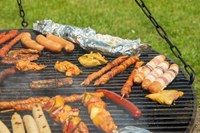Prairie Fare: Try the grilling safety quiz
(Click an image below to view a high-resolution image that can be downloaded)
“Did you just put a hamburger in your purse?” my husband asked.
He wasn’t supposed to notice that. In my defense, the sandwich was wrapped and came out of the fridge.
“I didn’t want to pack a lunch bag. The rest of my lunch is at work,” I replied.
Actually, I think he was just giving me a bad time, so I buttered him up with a compliment.
“The hamburgers you grilled were so delicious that I needed to tuck one in my purse for lunch,” I added.
He grinned. He likes being complimented on his culinary skills.
Grilling is especially popular at this time of the year. Grilling is a low-fat cooking technique that imparts flavor to foods.
Unfortunately, in my community, I have seen the aftermath of burned-down decks and at least one burned-down home as a result of fire safety issues associated with grilling.
This week we will consider fire safety, with a little help from the resources I found at the National Fire Protection Association (NFPA).
Let’s try some fire safety questions.
1. What is the peak month for grill fires?
- May
- June
- July
- August
2. What was the main reason for grill-related fires? (Choose one.)
- The grill was too close to a house.
- The grill was next to a wood railing.
- The grill was not cleaned properly.
- The person doing the grilling was inexperienced.
3. What type of grill was involved in most home fires?
- Electric grill
- Gas grill
- Charcoal grill
- Indoor grill
4. In the U.S., about how many patients went to the emergency room related to grilling accidents between 2017 and 2021, according to the Consumer Product Safety Commission?
- 5,000
- 11,000
- 15,000
- 21,000
5. Name at least three tips for grill safety (outside of food safety tips).
6. Name at least three food safety tips for grilling.
Here are the answers. Question 1: c. July; Question 2: c. Grill was not cleaned; Question 3: b. Gas grills are linked with more fires; Question 4. d. 21,00 people went to the E.R..
Question 5. These are a few tips about grill safety. Clean your grill thoroughly. Use a brush that will not leave behind bristles because several emergency incidents have been reported where people ingest a bristle. Do not leave your grill unattended. Keep children and pets away from grills during operation. Do not place your grill directly under hanging branches, close to railings or close to other structures that could catch on fire.
Question 6. Here are some food safety tips. Thaw foods in the refrigerator. Wash your hands before and after handling food. Use marinades safety. When grilling, bring a clean plate to serve the food. Cross-contamination can happen between raw and cooked food if the same plate used to transport the food to the grill is used as a serving plate. Cook to safe food temperatures. For quality, do not overcook items. The U.S. Department of Agriculture recommends 160 degrees Fahrenheit for ground beef and 165 degrees Fahrenheit for poultry, for example. Keep hot food hot after cooking (140 degrees Fahrenheit or above).
Enjoy grilling season. Visit www.ag.ndsu.edu/food and “Food Preparation” and then scroll to “Grilling.” Check out the other resources as you explore our website, such as grilling fruits and vegetables.
Here’s a fun dessert that goes together in minutes. You can try it with a variety of fruits, including apples, peaches, mixed berries or a customized mixture.
Grilled Fruit Crisp
2 tablespoons rolled oats
1 tablespoon brown sugar
2 teaspoons butter
1 cup fruit, sliced or diced
Preheat grill or oven to 350 F. Combine oats, brown sugar and butter in a bowl until crumbly. Cut fruit and place on 12-inch-by-12-inch foil sheet. Top with crumble mixture. Fold foil to create packet ensuring all sides are sealed. Grill for 15 minutes or until fruit is desired tenderness.
Each serving (with apple) has 90 calories, 4 g fat, 1 g protein, 13 g carbohydrates, 2 g fiber and 40 mg sodium.
(Julie Garden-Robinson, Ph.D., R.D., L.R.D., is a North Dakota State University Extension food and nutrition specialist and professor in the Department of Health, Nutrition and Exercise Sciences.)
NDSU Agriculture Communication – June 27, 2024
Source: Julie Garden-Robinson, 701-231-7187, julie.garden-robinson@ndsu.edu
Editor: Elizabeth Cronin, 701-231-7006, elizabeth.cronin@ndsu.edu




